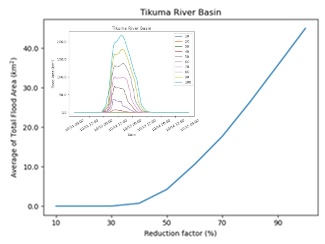Progress Report
Typhoon Control Research Aiming for a Safe and Prosperous Society[3] Impact Assessment of Typhoon Control
Progress until FY2024
1. Outline of the project
Typhoon control may cause climatic impacts, reduction of damages, and other social impacts. It is necessary to quantify these impacts to assess social acceptability. Estimating typhoon control’s economic damage reduction effects requires developing models to convert meteorological forces like wind speed and rainfall into structural or other countable damage. Out group has developed an integrated wind and flood damage assessment model for typhoon control. We are also analyzing the impact of typhoon control on other long-term socio-economic activities.
2. Outcome so far
Regarding climatic impacts, we have conducted numerical simulations assuming typhoon weakening by intervention at 1~15 hPa. Using the simulation dataset for 4 typhoon cases, we quantitatively estimated their impacts on the surrounding environmental fields. We found that systematic impacts of the typhoon weakening on the large-scale atmospheric field were insignificant within the 5~6 days after the intervention, while individual weather events were more sensitive to the modification.
Regarding wind disasters, we introduced a regional coefficient into a prefecture-level regional risk assessment model to enhance the model to reflect regional characteristics. We investigated that increasing/decreasing wind speed by just 5% roughly doubles/halves the number of damaged buildings and damage costs.
Regarding river flooding, we also advanced the development of a meteorological and hydrological hazard coupling prediction system and estimated flood inundation areas under specific typhoons with human intervention. Figure 1 shows an example of this, estimating the impact on flood damage costs for each member of the ensemble experiment results (TPES) obtained by changing the path of Hagibis. We estimated that reducing precipitation by 50% would result in zero inundation area.
Regarding storm surge disasters, we constructed a framework for estimating damage costs. We conducted calculations targeting Typhoon Hagibis and estimated direct damage costs. The assessment results indicate that a 30% change in central intensity results in approximately a 70% increase or decrease in damage costs. We also clarified that storm surge deviation and damage costs have a nonlinear relationship depending on inundation characteristics.
Furthermore, we analyzed the impact of typhoon control on medium- to long-term socio-economic activities. The results confirmed that only a very small number of residents understand the unique characteristics of large-scale flooding in the Tokyo metropolitan based on questionnaire survey.
3. Future plans
Advance the sophistication and integration of various types of wind and flood damage for damage estimation will be conducted. This theme will further develop the impact of typhoon control effects on impact based on the results of the climate control group.
